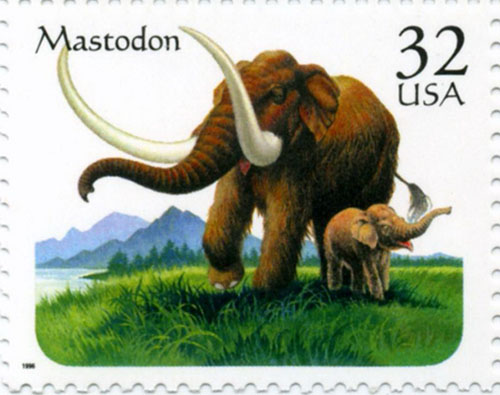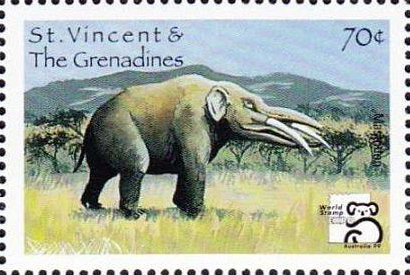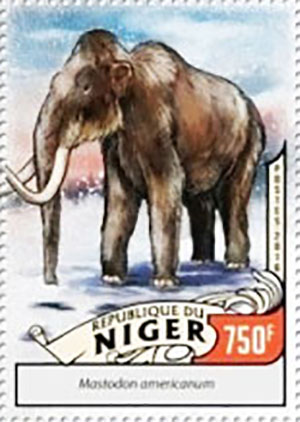Mammut americanum Kerr, 1792

(Da: it.wikipedia.org)
Phylum: Chordata Haeckel, 1874
Subphylum: Vertebrata Cuvier, 1812
Classe: Mammalia Linnaeus, 1758
Ordine: Proboscidea Illiger, 1810
Famiglia: Mammutidae Hay, 1922
Genere: Mammut Blumenbach, 1799
Specie e sottospecie
Il genere annovera attualmente le seguenti specie: Mammut cosoensis Schultz, 1937 - Mammut furlongi Shotwell & Russell, 1963 - Mammut matthewi Osborn, 1921 - Mammut nevadanum Stock, 1936 - Mammut pacificum Dooley et al., 2019 - Mammut raki Frick, 1933 - Mammut vexillarius Matthew, 1930.
Descrizione
Il nome nome specifico Mammut americanum deriva chiaramente dall'habitat in cui visse la parte orientale del Nord America. Appartenente alla famiglia Mammutidae, da non confondere con il mammuth, che invece appartiene alla famiglia Elephantidae. L'estinzione del mastodonte avvenne contemporaneamente a quella di molti altri appartenenti alla cosiddetta Megafauna del Pleistocene. Ne sono stati ritrovati dei resti in eccezionale stato di conservazione, che ci permettono di capire il loro aspetto fisico e, studiando il contenuto dello stomaco di uno di essi, perfino la loro alimentazione. I mastodonti avevano incisivi allungati a difesa non solamente della mascella superiore, ma anche di quella inferiore. Il nome deriva dai loro molari di forma arrotondata che, visti di profilo, ricordano la forma del seno femminile (da qui il nome desueto di Mastodon, "dente mammella").
Diffusione
Proboscidato primitivo vissuto da 4 milioni a 10.000 anni fa, nel Pliocene e Pleistocene, principalmente nella parte orientale del Nordamerica.
Sinonimi
= Elephas americanus Kerr, 1792 = Elephas macrocephalus Camper, 1802 = Elephas mastodontus Barton, 1810 = Elephas ohioticus de Blainville, 1839-1864 = Elephas rupertianus Richardson, 1854 = Harpagmotherium canadense Fischer de Waldheim, 1808 = Leviathan missourii Koch, 1840 = Mammut ohioticum Blumenbach, 1799 = Mammut oregonense Hay, 1926 = Mammut progenium Hay, 1914 = Mastodon acutidens Osborn, 1936 = Mastodon americanus ssp. alaskensis Frick, 1933 = Mastodon americanus ssp. plicatus Osborn, 1926 = Mastodon cuvieri Hays, 1834 = Mastodon jeffersoni Hays, 1834 = Mastodon moodiei Barbour, 1931 = Mastodon ohioticum Eichwald, 1832 = Mastodon rugatum Koch, 1845 = Mastotherium megalodon Fischer de Waldheim, 1814 = Missourium kochii Koch, 1840 = Missourium theristocaulodon Koch, 1843 = Tapirus mastodontoides Harlan, 1825 = Tetracaulodon bucklandii Grant, 1842 = Tetracaulodon collinsii Hays, 1834 = Tetracaulodon godmani Hays, 1834 = Tetracaulodon kochii Koch, 1841 = Tetracaulodon mastodontoideum Godman, 1830 = Tetracaulodon osagii Koch, 1841 = Tetracaulodon tapyroides Hays, 1834 = Trilophodon ohioticus Falconer, 1868.
Bibliografia
–Stanford, Donald E. (1959). "The Giant Bones of Claverack, New York, 1705". New York History. 40 (1): 47-61.
–Weld, Charles Richard (1848). "Chapter XV: 1710–1725". A History of the Royal Society: With memoirs of the Presidents. pp. 398-433.
–Semonin, Paul (2000). "Chapter 1: The Giant of Claverack in Puritan America". American Monster: How the Nation's First Prehistoric Creature Became a Symbol of National Identity. NYU Press. pp. 15-40.
–Warren, John Collin (1852). "Historical sketch". The Mastodon giganteus of North America. John Wilson and Son. pp. 1-3.
–Storrs, Glenn W. (2019). "Big Bone Lick". Ohio Valley History. 19 (3): 82-90.
–Daubenton, Louis Jean-Marie (1764). "Mémoire sur des os et des dents remarquables par leur gradeur". Histoire de l'Académie Royale des Sciences, Année MDCCLXII, avec les Mémoires de Mathématiques & de Physique, pour la même année, 1762: 206-229.
–Hedeen, Stanley (2008). "Chapter 4: Gathering the bones". Big Bone Lick: The Cradle of American Paleontology. University Press of Kentucky. pp. 31-44.
–Barnett, Lydia (2019). "Showing and hiding: The flickering visibility of earth workers in the archives of earth science". History of Science. 58 (3): 245-274.
–Semonin, Paul (2000). "Chapter 4: Big Bone Lick". American Monster: How the nation's first prehistoric creature became a symbol of national identity. NYU Press. pp. 84-110.
–Mayor, Adrienne (2005). "Chapter 1: The northeast: Giants, great bears, and grandfather of the buffalo". Fossil Legends of the First Americans. Princeton University Press. pp. 32-72.
–Daiutolo, Robert, Jr. (October 2015). George Croghan: The life of a conqueror (Ph.D. thesis). Graduate Program in History. New Brunswick–Piscataway, NJ: Rutgers University.
–Collinson, Peter (1767). "XLVII. Sequel to the foregoing account of the large fossil teeth". Philosophical Transactions of the Royal Society of London. 57.
–Hunter, William (1768). "V. Observations on the bones, commonly supposed to be elephants bones, which have been found near the river Ohio in America". Philosophical Transactions of the Royal Society of London. 58: 34-45.
–Annan, Robert (1793). "Account of a skeleton of a large animal, found near Hudson's River". Memoirs of the American Academy of Arts and Sciences. 2 (1): 160-164.
–Jefferson, Thomas (1785). Notes on the State of Virginia. Philippe Denis Pierres. pp. 42-80.
–Semonin, Paul (2000). "Chapter 5: The American incognitum in Paris". American Monster: How the nation's first prehistoric creature became a symbol of national identity. NYU Press. pp. 111-135.
–Semonin, Paul (2000). "Chapter 11: "Monarch of the wilderness"". American Monster: How the nation's first prehistoric creature became a symbol of national identity. NYU Press. pp. 263-287.
–Semonin, Paul (2000). "Chapter 13: Exhumation of the monster". American Monster: How the nation's first prehistoric creature became a symbol of national identity. NYU Press. pp. 315-340.
–Zygmont, Brian J. (2015). "Charles Willson Peale's The Exhumation of the Mastodon and the great chain of being: The interaction of religion, science, and art in early-federal America". Text Matters. 5 (5): 95-111.
–Hoffman, Sheila K. (2018). "The origins of Puritan politics in U.S. museums: Nation building and "the arts" from 1776 to 1806". ICOFOM Study Series. 46 (46): 131-145.
–Thomson, Keith Stewart (2008). "Chapter 6: Fossils and show business: Mr. Peale's mastodon". The Legacy of the Mastodon. Yale University Press. pp. 46-54.
–McMillan, R. Bruce (2022). "Albert C. Koch's Missourium and the debate over the contemporaneity of humans and the Pleistocene megafauna of North America". Earth Sciences History. 41 (2): 410-439.
–McMillan, R. Bruce (2010). "The Discovery of Fossil Vertebrates on Missouri's Western Frontier". Earth Sciences History. 29 (1): 26-51.
–Osborn, Harry Fairfield (1936). Proboscidea: a monograph of the discovery, evolution, migration and extinction of the mastodonts and elephants of the world. Vol. 1. J. Pierpont Morgan Fund by the trustees of the American Museum of Natural History.
–Warren, John Collin (1852). "Discovery of the skeleton". The Mastodon giganteus of North America. John Wilson and Son. pp. 4-7.
–Horenstein, Sidney (2008). "New York City Mastodons: Big Apple Tusks". Evolution: Education and Outreach. 1 (2): 204-209.
–Warren, John Collin (1852). "Geological situation and causes of preservation". The Mastodon giganteus of North America. John Wilson and Son. pp. 154-167. Hartnagel, Chris Andrew; Bishop, Sherman Chauncey (1922). The Mastodons, Mammoths and Other Pleistocene Mammals of New York State: Being a Descriptive Record of All Known Occurrences. University of the State of New York.

|
Data: 08/06/1996
Emissione: Animali preistorici Stato: U.S.A. |
|---|

|
Data: 01/03/1999
Emissione: Mostra Filatelica Internazionale Australia 99 - Animali preistorici Stato: St. Vincent and the Grenadines Nota: Emesso in un foglietto di 12 v. diversi |
|---|

|
Data: 15/08/2016
Emissione: Specie estinte Stato: Niger |
|---|